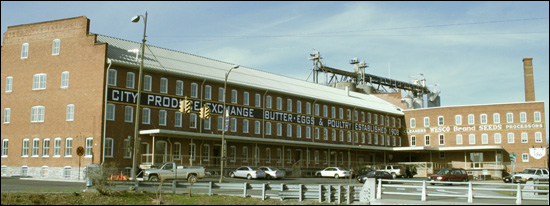Government
| Newer Posts |
Smart(er) Growth For Harrisonburg and Rockingham County? |
|
Wow! Today's Smart Growth Symposium, orchestrated by the Shenandoah Valley Builders Association was a fantastic primer on growth issues and how to plan for them in the central Shenandoah Valley. Stewart Schwartz, the Executive Director of the Coalition for Smarter Growth, provided a great overview of smart growth principles and policies that provided a helpful framework for thinking about and planning for the future of our area. One key point that he made, that stuck with me, was a need to focus on developing in the right place. Those present included conservationists, builders, farmers, real estate agents, bankers, local planning staff, elected officials, engaged citizens, and more. There seemed to be a great desire for and capacity to consider working together for the best future for our valley, despite the varying perspectives each of us bring to the table. | |
New Housing on Stone Spring Road - Changes in Zoning |
|
Per the January 18th Daily News Record, the Harrisonburg Planning Commission recommended that City Council approve a rezoning request of 72.6 acres on Stone Spring Road. Here are a few tidbits that might shed some light on the intricacies of this story:
| |
A Brief History of Harrisonburg's Annexations |
|
Annexation is the process whereby land is incorporated into an existing town or city. There have been several annexations in Harrisonburg's history, bringing the current size of the city to 11,132 acres. The largest annexation (7,450 acres) took place in 1983 --- shown in pink on the map below. (Map courtesy of the City of Harrisonburg).  Title 15.2 (Counties, Cities and Towns) of the Code of Virginia outlines how annexations are to take place. Here are some recent annexation related news items: Mount Crawford seeks to annex 243 acres to expand to 467 acres. Dayton discusses annexing along Route 257. Could Harrisonburg and Rockingham County see another annexation anytime soon? According to Brian, Harrisonburg's Director of Economic Development says the city has no plans to annex any portion of Rockingham County (source: Daily News Record). On a related note, according to Keith Markel, one of Harrisonburg's previous city planners, most of the zoning frustrations stem from the 1983 annexation. Much of that land was zoned R-3, which allows anything from single family homes to apartment complexes. However, this past year, the right to build apartment complexes in R-3 zoned land was removed. | |
Assessed Values - What and Where . . . |
|||
The assessed value of a property is the value assigned to the property by the local assessor's office, for the purpose of determining how much you will pay in taxes. Harrisonburg has a great "Understanding Assessments" guide on the Commissioner of the Revenue section of their web site. How to determine the assessed value of a property: For Harrisonburg, visit the new Real Estate Information System to view assessed values for properties, and lots of other property information. For Rockingham County, visit their GIS web site, where you can search for a property, and obtain its assessed value. Additionally, if you have trouble with either of these systems, feel free to e-mail me (scott@cbfunkhouser.com) --- I look up assessed values quite frequently, through both of the systems above, and through the MLS. I'd be happy to look up a property for you and e-mail you back with the assessed value. Real World Assessments Let's take a look at a few real world assessments compared to recent sale prices to see how they compare, starting with the three real estate closings from the past few weeks in our MLS for Harrisonburg . . .
It becomes clear that there is not a magical percentage that can be used to determine the market value of your home based on assessed values. Finally, here's one example of a house (that I am marketing) that is for sale at a price below the appraised value: 6210 Dotts Lane, Penn Laird (click here for details) Asking Price = $319,000 Assessed Value = $333,200 With amazing views, a large lot, a private neighborhood, schools in close proximity, superior construction quality, and a price below appraised value, it is a great opportunity! | |||
Counting JMU Students |
|
In most situations, it's o.k. if we aren't working with an exact number for JMU enrollment. However, many developers are currently spending a lot of money to build thousands of housing units in Harrisonburg --- many of which are intended to be occupied by JMU students. When you dig into the numbers, it starts looking like we will have a significant over-supply of college housing in the coming years . . . How Many Bedrooms?? Per today's Daily News Record, "more than 3,700 residential-housing units are under construction or in various stages of approval" --- of which 2,985 are apartments or townhouses. However, many of these are not 1-bedroom housing units, but 2, 3, or 4 bedroom. We'll assume for a moment that they average out at 2 bedrooms per unit. This provides us with 5,970 "beds" to fill --- and the article later states that by 2013, the city will need 2,500 additional beds for JMU students. Hmmmm.......so far that's 3,470 extra beds --- and I hope they aren't finished too quickly! What Is Headcount? The second problem (for developers spending lots of money on building these housing units) is that the figures being used for JMU enrollment can be a bit deceiving. The above-referenced article references 2013 enrollment as 21,500. The only enrollment projection I can find on SCHEV's web site close to 21,500 is the "Total Fall Headcount". This is defined by SCHEV as "A student enrolled for more than zero credit hours in courses offered for degree or certificate credit, or a student who meets the criteria for classification as a remedial student." My understanding is that this would include faculty or staff taking one (or more) class(es), students studying abroad, local residents taking one (or more) class(es), etc. All of these categories of "fall headcounts" wouldn't at all contribute to a demand for student housing. The Total Fall Headcount shows 21,542 students in 2013. For the best "living in Harrisonburg, needing student housing" enrollment figures, I am almost always pointed to the "Regular Session Full-Time Equivalent" data, which is defined by SCHEV as "A calculation of enrollment based on total credit hours taken byundergraduates and first professionals divided by 30 and added to totalgraduate credit hours divided by 24. Includes fall and spring semestersonly, does not include summer term enrollments. May be broken out by onand off-campus activity." This is a calculation to get a lot closer to the number of full time students will be attending JMU --- and these numbers show 19,333 students in 2013. Does it matter, or are we just splitting hairs? If you explore SCHEV's Enrollment Projections, you'll see that there are a lot of figures that can be used for estimating future JMU enrollment figures. My concern is that the figure that developers are using for their decisions is the highest number available -- and one that counts people who would not be seeking student housing. I can understand that the City and the Daily News Record use that highest figure in many situations, but when student housing developers use it for planning purposes, it may be a cause for concern. | |
Appealing Your (City) Property Assessment |
|
A reader posed the question of how or why might you appeal the assessed value assigned to your property by the City of Harrisonburg. Below is an overview of that subject, based mostly on information I gleaned from a conversation with Nancy Lawson at the City of Harrisonburg's Commissioner of the Revenue office. When determining new assessed values, the City of Harrisonburg always tries to get pretty close to the market value of the property --- but they are almost always under market value with their assessments. ("Market value" being defined as the amount you could obtain if you sold it.) They are often under market value because they use sales data from July 1 to June 30 --- and they release the new assessed values in November. So they are basing the new values on data that is 4 to 16 months old. However, regardless of the data being used, it is possible that the city could have assessed your property at too high of a value --- and there is an opportunity for recourse. The first step of the appeal process involves meeting with someone at the Commissioner of the Revenue's office about how they came to your assessed value --- this is called the informal review. There is a "worksheet" on file for your property showing the calculations they used to come to your assessed value. They can also share the information on comparable properties in your neighborhood, which they use to determine assessed value. If, after the informal review, you think they have assessed your property at too high of a value, you can file a formal appeal using this form. Click here for more assessment information from the City of Harrisonburg This all applies to the City of Harrisonburg. The process and details for properties in Rockingham County (or in any other city, town or county) are a bit different. If you live outside of the City of Harrisonburg and you're having trouble finding parallel information for another locality, let me know --- I'd be glad to help you research it. | |
Pay Reduced Capital Gains Taxes If Your Job Makes You Move |
|
 Capital gains are gains on assets that had been held for over one year before being sold. Roughly speaking, if you purchased your home for $200,000 and are selling it for $250,000 you have netted $50,000 of capital gains. This profit is taxable, with one significant exclusion. If, in the 5-year period ending on the date of the sale, you have: Capital gains are gains on assets that had been held for over one year before being sold. Roughly speaking, if you purchased your home for $200,000 and are selling it for $250,000 you have netted $50,000 of capital gains. This profit is taxable, with one significant exclusion. If, in the 5-year period ending on the date of the sale, you have:- Owned the home for at least 2 years (the ownership test), AND - Lived in the home as your main home for at least 2 years (the use test). then you will generally only be taxed if your gain is more than $250,000 ($500,000 if married filing a joint return). Yes, you really are exempt from any and all taxes on this profit. If you are selling your home less than two years after you bought it, or within two years of selling another home and claiming a capital gains exemption, you may still be able to reduce the amount of gain upon which you will be taxed. This is possible if you sold the home because of: - a change in place of employment - health - unforseen circumstances Per the IRS, "For this purpose, employment includes the start of work with a new employer or continuation of work with the same employer. It also includes the start or continuation of self-employment." The only other stipulation on the change in place of employment is that the move is greater than 50 miles. The IRS has volumes of information on this topic located here --- where you'll even find the worksheet and calculations to use to determine the amount of your potential tax liability. | |
Harrisonburg Lures Downtown Development |
|
Harrisonburg is putting financial incentives in place to encourage development in downtown Harrisonburg. According to the Daily News Record (DNR) on November 14, 2007, City Council is considering extending tax break incentives to developers who are building new structures downtown. Here's the math, as I see it, per the article.... A developer invests $10M in constructing a new building to get eight year waiver of tax assessments. If the assessed value were also $10M, the total waived taxes would be $472,000 ($10M / 100 * .59 * 8). That comes out at a nearly 5% savings over 8 years --- not bad! This new proposal would be similar to the city's existing program for renovating downtown buildings. These financial incentives led to the re-development of the City Exchange building (now apartments and a restaurant). Per the DNR, "Real estate developer Barry Kelley said the historic building incentives were critical to his projects, including the renovation of the City Exchange building into apartments and a restaurant."  | |
Assessments Up, Assessments Down |
|
"The city's annual reassessment shows a preliminary average increase in property values of 6 percent, according to Commissioner of the Revenue June Hosaflook." Source: Daily News Record, November 27, 2007 Interestingly, one of my clients e-mailed me earlier this week indicating that his assessed value had gone down approximately $2,000 from 2006 to 2007. Great news relative to his tax burden --- questionable news relative to the one-year change in the value of his house. Also this week, on WSVA's Home Show, we had a call from another city resident whose assessment decreased. According to the City, some neighborhoods went up dramatically in assessed value, and some went down year to year. The common thread in almost all of the neighborhoods was that the land assessment stayed constant or went up --- land almost always appreciates or holds its value. | |
Short-Term Rentals in Massanutten |
|
 We've seen it in the news for almost a year and half now --- a group of homeowners in Massanutten Village are suing other such property owners because of the use of homes in their community as short-term (or vacation) rentals. This seems to most commonly understood as rental periods of less than 30 days. We've seen it in the news for almost a year and half now --- a group of homeowners in Massanutten Village are suing other such property owners because of the use of homes in their community as short-term (or vacation) rentals. This seems to most commonly understood as rental periods of less than 30 days.The latest --- instead of just suing two families for their rental transgressions, the plaintiffs are now suing 28 property owners! The entire debate on this issue seems to be over interpretation of the Massanutten Village covenants and restrictions. Those being sued point out that these covenants don't explicitly prohibit short term rentals. Those doing the suing characterize short term rentals as a business use, which is prohibited per the covenants. The blow by blow:
| |
| Newer Posts |
Scott Rogers
Funkhouser Real
Estate Group
540-578-0102
scott@funkhousergroup.com
Licensed in the
Commonwealth of Virginia
Home Search
Housing Market Report
Harrisonburg Townhouses
Walk Through This Home
Investment Properties
Harrisonburg Foreclosures
Property Transfers
New Listings

